THE CARE OF BABY
CHICKS
Poultry Need: Feed, Water, Heat, Light & Space.
FEED:
Use a
commercial chick starter
for the first 8 weeks. On the first day cover the litter with newspaper
and spread some feed on the papers and have your feeders full also.
This will allow the new birds to find the feed. Use a
2 foot feeder for
each 25 chicks. After the first day remove the papers from the starting
area. Please refer to the order blank for feed protein levels for the
type of poultry you are ordering.
WATER:
Have a 1 gallon chick waterer
for each 50 birds. DIP THE BEAK OF THE CHICK IN THE WATER BEFORE YOU
TURN IT LOOSE. For the first 2 days add 3 tablespoons of table sugar to
each quart of water for extra energy. For best results, have either
Quik Chik,
Broiler Booster, or an
antibiotic
in the water. Your birds will be thirsty when you get them. A taste of
water right away helps them to find more water soon. Most baby bird loss
is caused because the bird doesn't start to eat or drink. Never let
your bird run out of water.
HEAT:
The temperature where the birds are should be 90 to 95 degrees for the
first week. Reduce the temperature 5 degrees per week until you get to
70 degrees. Then they shouldn't need any more heat. A good source of
heat is a 250 watt bulb.
(Red bulbs are better than white. They cause less picking.) Hang it 18
inches from the floor. The temperature directly under the bulb will be
higher than 90 degrees but the birds will adjust themselves to the area
they like. Use 1 bulb for each 50 chicks in cold weather. Use 1 bulb for
each 100 chicks in warm weather.
LIGHT:
If you use a heat bulb, this will also serve as the light you need.
Otherwise, be sure to give your birds light. Use a 75 watt bulb on dark
days. Have a small light for night - 15 watts or similar - to keep them
from piling.
SPACE:
Try to provide 1/2 square foot per bird at the start. For starting 50
chicks use a draft shield (see below) and make a circle about 5 to 6
feet across. For 100 birds, make the circle 7 to 8 feet across.
OTHER IMPORTANT MATTERS
DRAFT SHIELD:
Cardboard put in a circle
about 12 inches high around the birds helps cut down drafts on the
floor. Be sure the circle is large enough to allow the birds to get away
from the heat if they want to.
LITTER:
Wood shavings, rice hulls, or ground cobs make good litter. Do not use
cedar chips,sawdust (It is too small and the birds may eat it instead of
their food), or treated wood chips. Sand, straw, or dirt will also work
but are not as good as the others. Put the litter all over the floor at
least 1 inch thick. Keep it covered for the first day with newspapers
to keep the chicks from eating the litter instead of the feed. To avoid
possible leg problems, remove the papers after the first day for heavy
breeds and meat birds and after the third day for lighter breeds.
GRIT:
Starting the 3rd day sprinkle baby grit on the feed
daily as if you were salting your food. Avoid putting too much at any
one time as the bird may fill up on it instead of the feed.
PICKING:
Baby
birds will often pick each other if they are too hot, too crowded,or
without fresh air. Occasionally bright light also causes them to pick.
An ounce of prevention is worth a pound of cure when it comes to
picking. Sometimes, however, they pick for no apparent reason. To stop
it try putting in fresh green grass clippings several times a day and
darken the room. As a last resort, debeaking might
have to be done. Try cutting off about one-third of the top bill. Do
not cut the lower bill, just the top one. To treat birds that have been
picked, smear pine tar or black grease on the injured area.
SPECIAL SITUATIONS AFTER THE CHICKS ARRIVE
IF THE BIRDS HAD A HARD TRIP:
Instead of using the standard feed and water suggestions listed, try
this: Put 6 more tablespoons of sugar in each gallon of water. Then mix
some of this extra sweet water with some of your feed to make a soupy
mix. Give your birds this special feed and water mix for 3 to 4 days to
get them over the effects of shipping.
REAR END "PASTING UP":
Sometimes the stress of shipping causes the manure to stick to the back
of the bird. It is important to remove this daily. Pull off gently or,
better yet, wash off with a cloth and warm water. It will disappear in a
few days as the bird starts to grow.
AFTER FOUR WEEKS:
| 1. | Increase floor area to 3/4 square feet per bird. |
| 2. | Increase feeders to provide 2-1/2" to 3" of space per bird. |
| 3. | Increase waterers to one 5-gallon fount per 100 birds. |
| 4. | Make sure grit hopper is filled with proper sized grit. Check with your feed man. |
| 5. | Install roosts at back of brooder area. Allow four inches per bird with roost poles six inches apart. |
| 6. | Open windows in day-time. Leave only partly open at night. |
| 7. | Prevent water puddles around founts. Place founts on low wire platforms. |
| 8. | Birds can range outside on warm, sunny days, but only if clean range is available. |
Original Post: http://www.mcmurrayhatchery.com/chickcare.html
More How to Care for Baby Chicks FAQ's
My birds are
pecking at each other. How do I stop them from pecking?
Make sure the
birds are not overcrowding each other. Also stress, feed deficiencies, illness
and boredom all cause feather pecking. Add grass clippings or leafy alfalfa hay
to the pen to eliminate boredom. If this does not work, you may try an
anti-pick spray or anti-pick device which fits over the beak.
Can I have
the beaks trimmed on the baby chicks?
We do not offer beak trimming service for the simple fact that the beak will grow back if
the procedure is performed on birds under 6 weeks old. If you decide to have
the beaks trimmed we recommend having it done before the birds start to lay.
When will my
hens start laying eggs?
It varies from
breed to breed. Some breeds will start to lay as early as 17 weeks old and
other breeds may take up to 30 weeks before they start to lay.
Do you
recommend the Marek's Vaccination?
Yes! It is a
good idea to have them vaccinated as it helps build up their antibodies. A
single vaccination confers lifelong immunity, but is not 100% foolproof. About
5% of the chickens vaccinated can still get the disease anyway.
What is Marek's Disease and how do I control the disease?
Marek’s is a widespread disease affecting domestic
chickens in all sections of the world. It is characterized by lesions
affecting the nervous system, organs, and other tissues. Young chickens
under 16 weeks of age are most susceptible. There is no treatment for
Marek’s once the birds are infected. Chicks must be vaccinated as close
to the time of hatch as possible for the vaccine to be effective. Some hackeries
vaccinate all of their own breeding stock and strongly feel that you
should do the same. Vaccinating your birds for Marek's is another
appropriate step in strong poultry management. Don’t take any chances. When offered vaccinate your chicks prior to shipment of your order. Don’t
forget to mark your order blank in the appropriate location for
vaccination.
Vaccinations are offered by http://www.mcmurrayhatchery.com/faqwhatismareks.html and
http://www.efowl.com/?Click=44040 and
http://www.californiahatchery.com/?AffId=34 when requested at the time of ordering your new chicks
Should I
medicate my birds for worms right away?
You can do it
before they start laying, but if you medicate them after they start laying, you
must wait 30 days after treatment before you can use the eggs.
How much
light do my birds need once they begin to lay eggs?
For maximum egg
production, it is recommended that hens get 14 hours of continuous light each
day. They need periods of darkness as well. It is best to monitor the amount
of light they receive with a timer set to turn on and off consistently at the
same time every day.
How do I get
my chickens to lay in the nest box and not on the floor?
In order to coax
your chickens to use the nest box, it should be located 18 to 20 inches from the
floor. Also, try to eliminate any dark corners as they like to hide in dark
spots to feel protected while laying an egg.
How many nest
holes do I need for my hens?
Figure on about 7 hens per nest box hole.
What is
causing my chickens to loose their feathers?
Chickens go
through a normal molting stage at about 18 months old. This molting period
usually lasts for 3 to 4 months. Egg production will cease during the molting
period, but will resume at a slower rate after the birds end molting.
..






 DIY: Chicken Manure Tumbling Composter!
DIY: Chicken Manure Tumbling Composter!



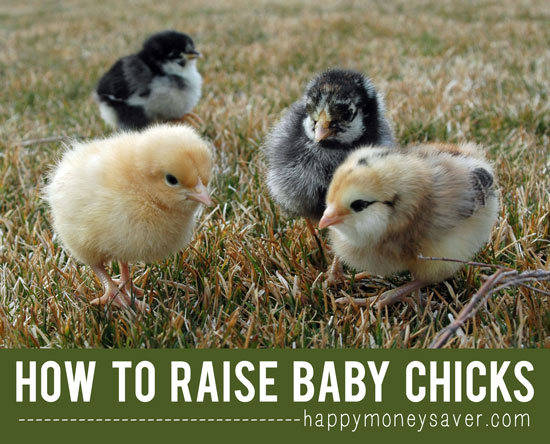
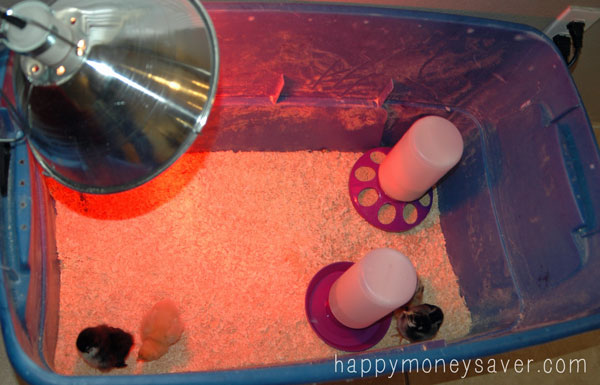 A brooder box or bin to keep them in. You can use a
stock tank, swimming pool, your bathtub or even an old kids swimming
pool. I used a plastic tote for my chicks since I already had them
hanging around my garage. Some people use a cardboard box as well, but I
don’t recommend it.
A brooder box or bin to keep them in. You can use a
stock tank, swimming pool, your bathtub or even an old kids swimming
pool. I used a plastic tote for my chicks since I already had them
hanging around my garage. Some people use a cardboard box as well, but I
don’t recommend it. A Heat Lamp + Heat Bulb. When you buy your heat bulb
try to get the red light heat bulb. Chickens will peck each other to
death if they see blood, so the red light will make everything red thus
avoiding any pecking injuries. You could also use a white heat lamp as
well and just keep a good eye out for them. Consider also keeping a
backup heat lamp just in case one burns out.
A Heat Lamp + Heat Bulb. When you buy your heat bulb
try to get the red light heat bulb. Chickens will peck each other to
death if they see blood, so the red light will make everything red thus
avoiding any pecking injuries. You could also use a white heat lamp as
well and just keep a good eye out for them. Consider also keeping a
backup heat lamp just in case one burns out. A Waterer and a Feeder - I used these little plastic
ones you can find at feed stores for a couple of bucks each. Make sure
and change out their water every day as they often poop and kick
shavings in them.
A Waterer and a Feeder - I used these little plastic
ones you can find at feed stores for a couple of bucks each. Make sure
and change out their water every day as they often poop and kick
shavings in them.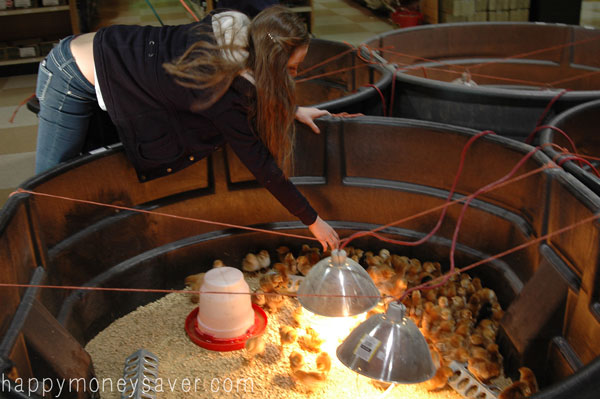 I called the feed store in my town to see when they have their “chick
days.” Turns out most feed stores have a day where they will get in a
huge lot of baby chicks where you can choose to pick up just a few or a
large lot of chicks. Some even offer free deals where if you buy the
feed you will be able to get a free chick. Make sure when you call you
ask what breeds of chicks they will be getting in.
I called the feed store in my town to see when they have their “chick
days.” Turns out most feed stores have a day where they will get in a
huge lot of baby chicks where you can choose to pick up just a few or a
large lot of chicks. Some even offer free deals where if you buy the
feed you will be able to get a free chick. Make sure when you call you
ask what breeds of chicks they will be getting in.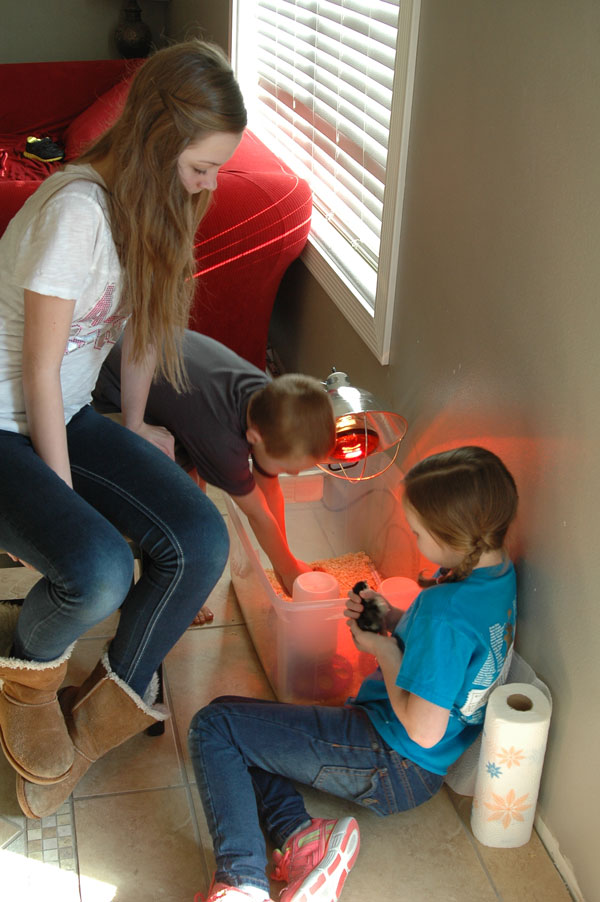 Whether you just came back from the post office or the feed store with
your new baby chicks in hand, make sure all you have their nice little
brooding box all ready to go. Make sure you have read all about how to
raise baby chicks so you are prepared.
Whether you just came back from the post office or the feed store with
your new baby chicks in hand, make sure all you have their nice little
brooding box all ready to go. Make sure you have read all about how to
raise baby chicks so you are prepared.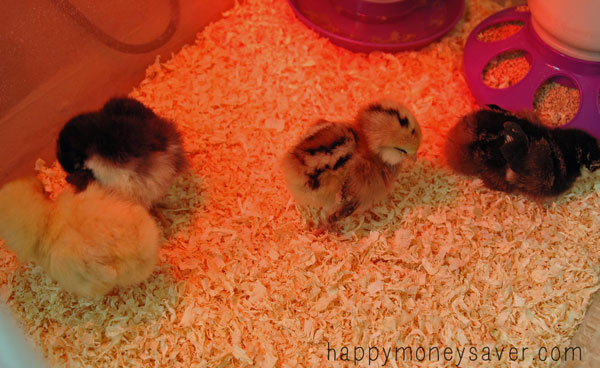 Then they will chirp around, eat their feed, poop and sleep. They will
just be running one minute and then drop like they are dead the next.
Then they will chirp around, eat their feed, poop and sleep. They will
just be running one minute and then drop like they are dead the next.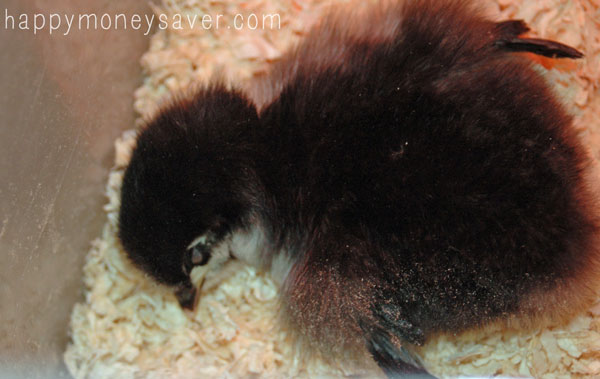 The drop-dead-look is normal, it’s just how they sleep. They are so adorable.If you find your chicks are constantly kicking their pine shavings
into your waterer, add a book covered in a ziplock bag or a weight
underneath. It helps a little. But still check the waterer often for
poop and shavings. Wash it in soap & water periodically also to keep
them healthy.
The drop-dead-look is normal, it’s just how they sleep. They are so adorable.If you find your chicks are constantly kicking their pine shavings
into your waterer, add a book covered in a ziplock bag or a weight
underneath. It helps a little. But still check the waterer often for
poop and shavings. Wash it in soap & water periodically also to keep
them healthy.
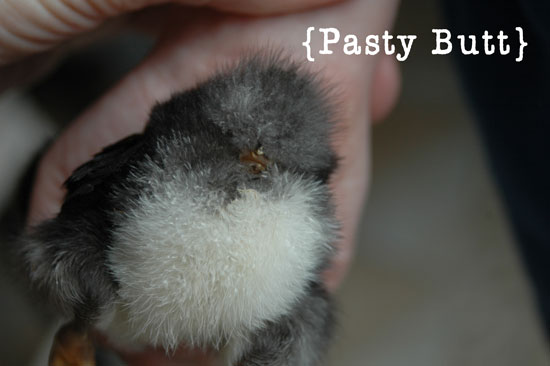 So when your chick gets Pasty Butt you just need to take a warm wash
cloth and wash the poop off gently. No picking it off, it can hurt them.
We had our baby chick sit in some warm water (in a bowl) and gently
washed it off.
So when your chick gets Pasty Butt you just need to take a warm wash
cloth and wash the poop off gently. No picking it off, it can hurt them.
We had our baby chick sit in some warm water (in a bowl) and gently
washed it off. Problem is when they have wet feathers, the others will peck at them
so you will want to separate them until dry. My son held our chick with a
wash cloth until she was dry. He loves doing things like that.
Problem is when they have wet feathers, the others will peck at them
so you will want to separate them until dry. My son held our chick with a
wash cloth until she was dry. He loves doing things like that.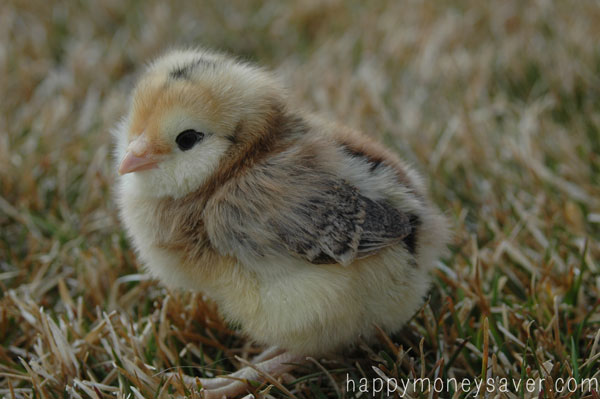 The heating lamp should be placed 12-18 inches above the floor
of the heating area. Some signs that your heat is too low- Your chicks
will huddle together in the brooder. If the temperature is too high,
your chicks may be dispersed throughout the heating area, and they may
look tired. If the temperature is set correctly, your chicks will be
evenly dispersed throughout the heating area, and they will look lively
while making lots of peeping sounds!
The heating lamp should be placed 12-18 inches above the floor
of the heating area. Some signs that your heat is too low- Your chicks
will huddle together in the brooder. If the temperature is too high,
your chicks may be dispersed throughout the heating area, and they may
look tired. If the temperature is set correctly, your chicks will be
evenly dispersed throughout the heating area, and they will look lively
while making lots of peeping sounds!








 Ragdolls were developed in the 1960’s by Ann Baker; a
breeder in Riverside California. The origin of the Ragdoll
breed consisted almost entirely of free-roaming cats. Ann
bred Josephine, a domestic longhaired white female that
was found running loose in her neighborhood, to other
cats she owned or found. The offspring of this female
had unique temperament traits that were very endearing.
By selecting individuals with the look, temperament and
criteria she wanted for her breeding program, she created
the Ragdoll breed.
Ragdolls were developed in the 1960’s by Ann Baker; a
breeder in Riverside California. The origin of the Ragdoll
breed consisted almost entirely of free-roaming cats. Ann
bred Josephine, a domestic longhaired white female that
was found running loose in her neighborhood, to other
cats she owned or found. The offspring of this female
had unique temperament traits that were very endearing.
By selecting individuals with the look, temperament and
criteria she wanted for her breeding program, she created
the Ragdoll breed.